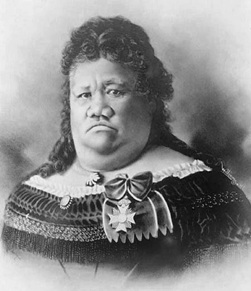
Some faces stop clocks. This one stopped a lava flow, and saved a city. Nina Morgan explains.
Geoscientist 21.04 May 2011
The Island of Hawaii, known to the natives as 'big island' sits over a mid-Pacific hot-spot, and has long been famous for its four active volcanoes – Kilauea, Mauna Loa, Hualalai and Haleakala. As an article in the New York Times, dated 23 October 1890, put it:
"The latest news and photographs from the Volcano [Kilauea] supplemented with reliable stories from eye-witnesses testify that Hawaii's natural wonder is probably at present the greatest volcanic phenomenon in the entire world."
The relatively non-explosive eruptions on Hawaii, which are characterised by slow moving lava flows, provided spectacular views that gripped the imaginations of a group of artists who became known as the Volcano School. One of these, Charles Furneaux, who arrived in Hawaii in July 1880, accurately recorded in a series of paintings the nine-month eruption of Mauna Loa that began that year. Like many, Furneaux revelled in the stunning sights it created.
But this eruption took on a more dangerous aspect in May 1881 when the lava flow increased significantly and headed towards the city of Hilo. Normally in such circumstances native Hawaiians would turn to Pele – the goddess of fire, lightning, dance and volcanoes – for salvation. But on this occasion, the threat was so serious that more help was needed. It came – so legend has it – in the considerable form of Princess Ruth Luka Keanolani Kauanahoahoa Ke'elikolani (1826 – 1883).
A member of the Hawaiian royal family and Governor of the Island of Hawaii, Princess Ruth was a formidable figure. Over 1.8 metres tall, weighing over 200 kg, and with broad features including a nose flattened by surgery, she had a voice described as a 'distant rumble of thunder'. A staunch defender of ancient Hawaiian traditions and customs, she stepped in, chanted prayers and gave offerings to Pele . The lava flow stopped on 10 August 1881, not far from Hilo. Pele had clearly met her match, and Princess Ruth was duly credited with saving the city.
Acknowledgment
This vignette was inspired by an exhibition of paintings by the Volcano School at the Bishop Museum in Honolulu, Hawaii, and much of the information it contains comes from captions to the pictures on show.
- If the past is the key to your present interests, why not join the History of Geology Group (HOGG)? For more information and to read the latest HOGG newsletter, visit: www.geolsoc.org.uk/hogg.
* Nina Morgan is a geologist and science writer based near Oxford.